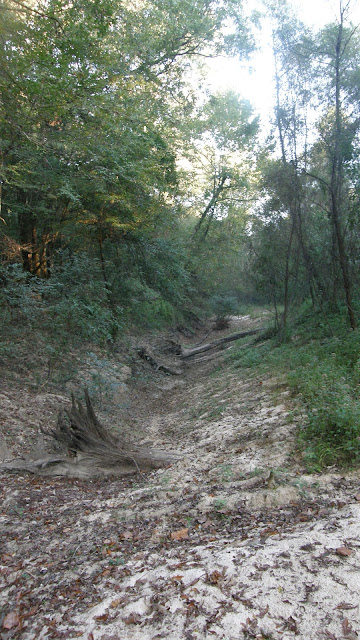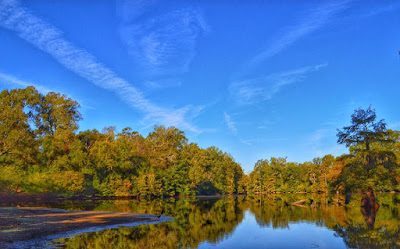Brian and I revisited the Hutson Lake area for an extended hike, with our friend Curtis Holland of Laurel as guest. We intended to introduce Curtis to the grandfather cypress we call the Ancient of Days, and to hike the long trail I call Hollow Man Road to its namesake, all the while reexamining the area for feeding sign and woodpecker cavities that we might have missed on previous surveys. I also wanted to revisit the remote southeastern corner of this sector, to attempt to locate yet another titan cypress I had glimpsed from afar during a solo hike back in December of 2014.
I will provide photos and video, with little additional commentary.
We passed a mature black cherry that had been downed by high winds, and later had to work our way through the canopy of a mature water oak that had uprooted and crashed across the trail. A mile or two on down Hollow Man Road, Brian again spied a tree with what appeared to be extensive bark stripping, this time on a living oak. Bringing our binoculars to bear on the subject, we saw this:
What looks to be classic Campephilus-style extensive bark stripping. Excited, we shed our packs and plunged through the undergrowth to get a closer look. We soon discovered what was responsible:
We were by that time rather spent, but I wanted to try to find the phantom cypress that had eluded me during my last winter visit, and which I was beginning to think might have been only a figment of my imagination. We struck out on the trail eastward from Hollow Man, crossing into mixed bottomland forest that quickly gave way to swamp forest, now mostly dry. I scanned the area, looking for the great tree, but did not see him, until the three of us had turned around to begin the long hike back. Then, through the trees, I spied him. Making our way through some difficult terrain along the changeable swamp edges, we finally got a clear view:
The first thing that came out of my mouth, after I'd gotten a good look at him, was: "Lord God." I decided immediately that's what I wanted to name him.
We bid farewell to our new friend, and began the long hike back up Hollow Man Road to Hutson Lake. Once, about halfway there, a Pileated Woodpecker bulleted across the trail ahead of us, and Curtis let out a small gasp. "Was that?..."
I knew exactly how he felt.
(For more high-quality photos of our Ivorybill journeys, please visit my brother's Facebook page, called 'The Humble Hiker.')
I will provide photos and video, with little additional commentary.
Hutson Lake. The water level is still very low. (Photo: Brian Carlisle.)
Near Hutson Lake. (Photo: Brian Carlisle.)
(Photo: Brian Carlisle.)
(Photo: Brian Carlisle.)
Curtis meets the Ancient of Days.
I apologize for the at times screwy video angle.
(Photo: Brian Carlisle.)
(Photo: Brian Carlisle)
(Photo: Brian Carlisle.)
(Photo: Brian Carlisle.)
Dry swamp forest to the north of Hutson Lake.
(Photo: Brian Carlisle.)
(Photo: Brian Carlisle.)
(Photo: Brian Carlisle.)
Brian calls this the Butterfly Trunk. (Photo: Brian Carlisle.)
Brian discovered a small pool within the dry swamp floor.
It was, we discovered, occupied.
Curtis and I leaving the Gar Pool Swamp. (Photo: Brian Carlisle.)
Curtis and I on Hollow Man Road. (Photo: Brian Carlisle.)
(Photo: Brian Carlisle.)
Not far along Hollow Man Road, eagle-eyed Brian spied a cypress with some heavy bark stripping. Earlier conversations on the subject with Mark Michaels of Project Coyote lead me to suspect this as the work of squirrels, though I have never seen bark stripping on a cypress as extensive as this. There were no marks to indicate to me that this was woodpecker-work.
We passed a mature black cherry that had been downed by high winds, and later had to work our way through the canopy of a mature water oak that had uprooted and crashed across the trail. A mile or two on down Hollow Man Road, Brian again spied a tree with what appeared to be extensive bark stripping, this time on a living oak. Bringing our binoculars to bear on the subject, we saw this:
What looks to be classic Campephilus-style extensive bark stripping. Excited, we shed our packs and plunged through the undergrowth to get a closer look. We soon discovered what was responsible:
The tree base, nearly destroyed by lightning. Curtis found long strips of wood lying in the brush 10-15 yards from the tree.
One can see in this poor quality photo the trail left by the lightning as it coiled up the bole to blast out of the crown.
A large woodpecker cavity already known to us, in a water oak overlooking the trail.
My brother is not one to pass up an area we have not looked at. Curtis and I rested on a downed tree at the trailside while Brian set off to examine a dry slough nearby. Presently I heard his bob-white whistle to try and get my attention. This is what he'd found:
A very large woodpecker cavity in a living cypress. We imagine it is at least the work of a Pileated Woodpecker.
Shortly thereafter, we paid our respects to Hollow Man himself, whose bed has dried up since my last visit.
We were by that time rather spent, but I wanted to try to find the phantom cypress that had eluded me during my last winter visit, and which I was beginning to think might have been only a figment of my imagination. We struck out on the trail eastward from Hollow Man, crossing into mixed bottomland forest that quickly gave way to swamp forest, now mostly dry. I scanned the area, looking for the great tree, but did not see him, until the three of us had turned around to begin the long hike back. Then, through the trees, I spied him. Making our way through some difficult terrain along the changeable swamp edges, we finally got a clear view:
The first thing that came out of my mouth, after I'd gotten a good look at him, was: "Lord God." I decided immediately that's what I wanted to name him.
(Photo: Brian Carlisle.)
As with the other titans we have encountered, Lord God Tree was spared the axe and saw only because he is hollow. Would that more of his kind had been hollow, too. (Photo: Brian Carlisle.)
(Photo: Brian Carlisle.)
(Photo: Brian Carlisle.)
Taking our last leave of the Lord God Tree.
I knew exactly how he felt.
(For more high-quality photos of our Ivorybill journeys, please visit my brother's Facebook page, called 'The Humble Hiker.')







































































